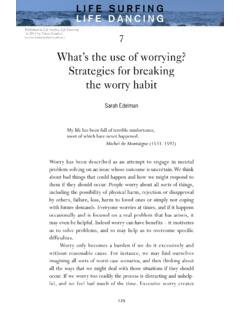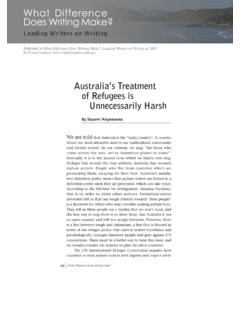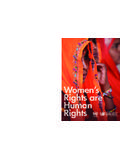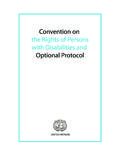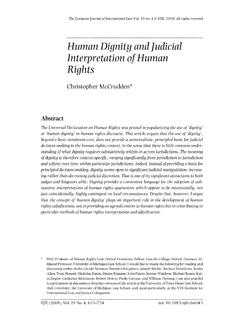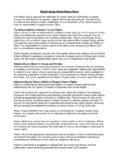Transcription of The Australian Constitution and Our Rights
1 The Australian Constitutionand Our RightsCheryl SaundersThe Australian Constitution says very little about humanrights. In contrast to the Constitutions of most other Westerncountries, which list a range of Rights and provide legal protec-tion for them, the Australian Constitution includes only a smallhandful of provisions that deal expressly with Rights . A fewother Rights have been implied from the text and structure ofthe Constitution . Apart from these, Australia relies on institu-tional mechanisms for Rights protection: the Parliaments andgovernments of both the Commonwealth and the States andindependent courts applying common law principles. Thischapter describes and explains how various arrangements work,as a necessary basis on which to consider whether more exten-sive constitutional protection of Rights would be useful anddesirable in may be helpful at this stage to clarify what we meanwhen we talk about human Rights .
2 At their most basic, humanrights are designed to ensure that each person can to live withdignity; free from fear, persecution and violence; productively;and harmoniously alongside others. As the understanding ofhuman Rights has developed, within countries and under inter-national law, they are often conceptualised in several and political Rights provide a framework within whichpeople can participate as equals in a democratic community,subject to the rule of law. They include, for example, the right117 FUTURE 18/2/10 11:11 AM Page 117 CHERYL SAUNDERS118 FUTURE JUSTICEto vote, freedom of speech and protest, personal liberty, theright to property and various guarantees of fair treatment, bothgenerally and under the criminal law. Many of these rightsrequire restraint on the part of governments in exercising theauthority of the state. A second category of Rights compriseseconomic, social and cultural Rights : to housing, to education, tohealth care, to employment, to live in accordance with yourown customs and traditions.
3 Many of these Rights requirepositive action on the part of governments in managing theresources of the state. A third category of Rights , which are likelyto become increasingly important, concern the require positive action on the part of the state as well. Most of the discussion about whether and how aConstitution should protect Rights focuses on the first of thesecategories: civil and political Rights . This chapter will focus onthese as well. We note, however, that this does not imply thatthe other categories of Rights are unimportant. It merely reflectsthe dominant view that they are more difficult to protect byconstitutional means. We also note that the dominant view isstrongly challenged by developments elsewhere. Famously, theSouth African Constitution has experimented with a way ofeffectively protecting social and economic Rights , with promis-ing results.
4 And in 2005, the Constitution of France wasamended to include a Charter for the Environment, whichcommits the state to public policies that protect is fortunate in the stability and efficiency of itsdemocracy and the commitment of its institutions to the ruleof law. The Australian legal and political system also stems froma tradition that accepts that the Rights of individuals should berespected by the state. As a result, so far, the Australian approachto Rights protection has worked reasonably well. By interna-tional standards, Australia has a good human Rights is regularly ranked highly in international assessmentsof the most desirable places in which to live. Such rankingstypically take into account the protection of human 18/2/10 11:11 AM Page 118 THE Australian Constitution AND OUR RIGHTS119 FUTURE JUSTICEThe Australian record is far from perfect, however.
5 On thisground alone, the Australian approach to Rights protectiondeserves critical scrutiny. Nor can Australia afford to becomplacent about maintaining even present standards of rightsprotection. The Australian approach relies heavily on a politicalculture that respects Rights . Political culture changes over timeand Australia does relatively little to reinforce the understand-ing of the significance of Rights and the willingness to givethem priority that such a culture evidence for the shortfall in Rights protection comesfrom the findings of international bodies in relation to, forexample, the treatment of indigenous Australians and asylum-seekers. Other evidence, ironically, comes from decisions ofcourts enforcing other constitutional or statutory provisions thatindirectly identify actions by governments and parliaments thatappear to have infringed Rights .
6 Some examples are set outbelow. In some cases the infringement of Rights is deliberate. Inothers, however, it is inadvertent; the consequences of imple-mentation of a policy without fully considering its Rights impli-cations, in the absence of a constitutional incentive to do following are examples of situations in which govern-ment action that appears to infringe Rights has been identifiedin judicial decisions, which sometimes also have provided aremedy. The right most obviously in issue is identified in brack-ets after each example: removal of the right of prisoners to vote, no matter howshort their sentence (right to vote) creation of a criminal offence to criticise the IndustrialRelations Commission in a way that is calculated to bring itinto disrepute (freedom of speech) protection for the official bicentennial of British settlementin 1988 that prevented a group of Aboriginal Australiansfrom selling t-shirts with a slogan that read: 1788 1988: 200years of suppression and depression (freedom of speech) 18/2/10 11.
7 11 AM Page 119 CHERYL SAUNDERS120 FUTURE JUSTICE dissolution of the Communist Party of Australia (freedom ofassociation) indefinite detention of a 25 year-old asylum seeker who wasstateless and could not be deported to another country(liberty) continued incarceration of a person who had served hissentence but was deemed still to be dangerous to thecommunity (liberty) criminalisation of homosexual conduct between consentingadults (equality) compulsory acquisition of property without adequatecompensation (property)We will return to some of these examples in the discussion Constitutional Provisions that Protect RightsThis part identifies the few express Rights -type provisions in theAustralian Constitution and describes what they do. We use theterm Rights -type provision because these provisions tend to beexpressed as limits on Commonwealth power, rather than aspositive Rights .
8 By way of example, the provision dealing withreligious freedom, described below, prohibits the Common -wealth from making a law to affect religious freedom in partic-ular ways. In contrast, section 2 of the Canadian Charter ofRights and Freedoms recognises that Everyone has the follow-ing fundamental freedoms and goes on to list five suchfreedoms, including freedom of conscience and religion. Property Rights receive some protection from section 51(xxxi) of the Constitution . This paragraph gives theCommonwealth Parliament power to acquire property andthen limits the power by requiring property to be acquired on just terms . This means that people have the right to befairly compensated if their property is acquired under aCommonwealth law. Like most of the constitutional provisionsdealing with Rights protection, the section does not apply 18/2/10 11:11 AM Page 120 THE Australian Constitution AND OUR RIGHTS121 FUTURE JUSTICES tate law.
9 The States have legislation that requires them tocompensate people if their property is acquired but this legisla-tion does not have constitutional by jury is protected under section 80 of theConstitution. A jury trial involves 12 ordinary people in deter-mining whether an accused person is innocent or guilty and itis therefore an important aspect of due process in the criminallaw. The section guarantees jury trial only for any indictable offence under Commonwealth law. It is up to theCommonwealth Parliament to decide whether to use theparticular procedure of indictment or not, but most seriousoffences are expected to be tried in this way. Again, section 80applies only to Commonwealth offences, not to offences underState law, which are governed by State legislation. Some aspects of religious freedom are protected bysection 116. The section prevents the CommonwealthParliament from enacting a law that would establish a nationalreligion, impose a particular religious observance, prohibit theobservance of a particular religion or require a religious test asa qualification for holding public office.
10 Consistently with theprovisions dealing with property and trial by jury, the sectionprotects religious freedom only against Commonwealth andnot against State , two sections provide a guarantee of internal mobil-ity within Australia or, in other words, the right to move freelyaround Australia. Under section 92, trade, commerce and inter-course among the states is required to be absolutely free .While this section has obvious commercial overtones, it isaccepted to apply to non-commercial movement of people aswell. The effect of section 92 is reinforced by section 117,which prevents discrimination against citizens operating in oneState on the grounds that they live in another State. Both thesesections were important to the original goals of federation inAustralia and, unlike the sections considered earlier, theyimpose limits on what the States can do.

